|

by
Alessandro Demontis
December 2009
received by Email
In his book “General History”,
Antonio de Herrera y Tordesillas, reports some legends he had
been taught by the Nahuatl tribes.
The most important among these tells us
that:
“In a very ancient time 4 tall men
came by sea… they had long beard, pale skin, and they were
extremely tall”.
These men discovered that the land they
settled in was inhabited by primitive people, and was a very fertile
land rich with lots of gold. The legend also tells us that "These
men carried along the secret of time", a reference to the fact
that it was them who started to count time in Mesoamerica creating
the first Mesoamerican calendar.
The “Codice Vaticano-Latino” (also call
Badianus Manuscript or Boturini Codex)
gathered this and other stories told to
the Spanish after the conquer by the local tribes, in their journey
from Mexico to Peru.
Particularly amazing is the story of the “Five Ages or Suns”, an
Aztec legend that came from a more ancient Mayan one.
The Codice reports that the First Sun
ended 13.133 years before the writing of the Codice itself because
of a huge flood. According to the tale, humanity was safe because 2
people were saved by a god: Nene and his wife Tata.
The First Sun lasted 4008 years, the Second Sun lasted 4010 years,
and the Third Sun lasted 4081 years. The Fourth Sun began, according
to the Codice, “5042 years ago” but there was no trace of how long
it would last nor when would it end.
The only other information was that the
Fifth Sun would finish in
2012 AD.
Now, remembering that the Codice was written around 1533 AD, this
date is enough to calculate the starting dates of all 5 Suns, the
‘fundamental dates of History’ according to the Aztecs:
-
Writing of the Codice: 1533 A.D.
-
Start of the Fourth Sun: 1533 –
5042 = 3509 B.C.
-
Start of the Third Sun: 3509 –
4081 = 7590 B.C.
-
Start of the Second Sun: 7590 –
4010 = 11600 B.C.
-
Start of the First Sun: 11600 –
4008 = 15608 B.C.
We have to add the information that the
Fifth Sun would end in 2012 A.D., so we have a lap of time dating
from 3509 B.C. to 2012 A.D. that covers 2 Suns.
A period of time of only 5521 years.
Since the other Suns lasted some 4000 years each, this data is very
anomalous. It is worth remembering another information: the
Long
Count calendar starts in 3113 B.C. (or 3114 whether we consider
‘year 0’ or not) and was calculated, according to the legend, since
the arrival of Quetzalcoatl (Kukulkan for the Maya).
Now let’s try to make a comparison
between the data covered by
Zecharia Sitchin and the prehistory of
Mesoamerica. Sitchin contends that the Mesoamerican civilization
rose because of the settlement of some of
the Anunnaki in Mexico and
in Peru, moving from Sumer with the aid of some humans recruited in
Sumer and in Western Africa (and Egypt).
Sitchin goes on stating that there were
two distinct fluxes of deities and people: one originated the
myth
of Viracocha, the other originated the myth of Quetzalcoatl.
-
Viracocha was described in legends as a ‘tall man with long beard,
pale skin and using a rod that emitted thunders and lightnings’
-
Quetzalcoatl was the ‘Feathered serpent’, tall and mastering of the
‘secret of arts and time’
-
According to the Toltec and
Aztec legends they both came by sea
I think it is due, at this point, to spend some time entering in
details about these two deities, who were secondary characters at
Sumer, but preeminent deities in Mesoamerica and South America.
The identification of these 2 deities is mostly made by iconography.
In the case of Ningishzidda/Quetzalcoatl we also have mythological
common traits, like the attribution to both deities of a central
role in the process of creating and instructing humanity.
Ningishzidda was a pacific god, depicted with two entwined snakes,
and when it was depicted in human form he had 2 horned snakes rising
from his shoulders.
He was a cleaver engineer and architect,
in fact King Gudea left us a tablet where he tells the story of the
dream he had about building the Girsu for Ninurta, in Lagash.
-
In the
dream it was Ningishzidda who told him how to erect the Girsu and
how to settle it in accordance with the ‘signs in the sky’. He was
called ‘Falcon of the Gods’, a name that bestowed him a reference to
birds and flight. In this manner he was adored in Mexico as the
‘Flying and Feathered Serpent’, who educated the men and instructed
them on how to write, build, etc.
-
Ishkur, instead, was a warrant god, depicted as a tall man with a
long beard standing on a bull. He had lightnings or a trident of
lightnings in one hand, and an axe in the other.
-
These objects were
also attributes of Viracocha, often depicted with lightnings
bolts in one hand, and an axe or golden rod in the other
The first king
of the Cuzco civilization, called Manco Capac IV, an adorer of
Viracocha, is often depicted with the golden axe of Viracocha in his
hand.
Capac IV was a descendant of the first
Manco Capac who founded Cuzco around 2400 B.C. According to the
legend, it was Viracocha who gave Manco Capac I a golden rod/axe
telling him to build a center of cult for him in the place where the
rod would fall and penetrate the ground.
These two gods settled in Mesoamerica
and southern America in two different times and locations,
-
Quetzalcoatl in Mexico, where the feathered serpent is present in
many sacred buildings and architectonic motives, (among the most
famous places we can recall La Venta, Tollan, Teotihuacan,
Xochicalco, Chichen Itzà)
-
Viracocha in Peru where, on the shore
reefs, we can still see the ‘Candelabra of the Andes’ (far below
image), a gigantic
glyph showing a trident that is the precise copy of the one depicted
in some clay tablets representing Ishkur.
It is also interesting to notice that the name ISH.KUR was the focus
of certain linguistic controversy.
If the word KUR is clearly
Sumerian, meaning ‘Mountain’, the root ISH is not Sumerian but
Akkadian, deriving from ISHA that meant LORD. Reading ISHKUR as an
Akkadian name, thus, defines him as the ‘Lord of the Mountain’,
which is an obvious reference to the fact he was in charge on the
Zagros region, but also claiming a similarity to the mountain
regions of the Andes where the Candelabra still lays, and the myth
of Viracocha was born.
The ‘akkadian bound’ between Ishkur and
Viracocha also shows out from a comparison of the dates. The cult of
Viracocha is thought to be born around 2400/2100 B.C., which, in
Mesopotamian lands, was the period of Akkad.
The big problem in accepting the correlation we have shown so far,
is that people do not accept that Mesoamerican and Mesopotamian
civilizations could have met. The establishment tells us that the
oldest Mesoamerican civilization dates back to 1400 BC, ignoring
that some legends in the Codice and similar documents tell us
clearly that various cities like Cuzco and Tlatilco were inhabited
about 4000 years before the writing of the Codice.
This would lead to a date of about 2500
BC, a date that the establishment refuses to accept. Many scholars
say that the Sumerian culture could never have been in contact with
Mesoamericans because by 1400 BC the Sumerian culture had already
disappeared, leaving ground to the Assyrian and Babylonian ones,
which had a very different cuneiform system.
It’s obviously impossible to establish the exact dates when these
two Sumerian gods arrived in Mexico and Peru, but we can try to
establish some ‘theoric’ dates putting the dates of the Suns in
correlation with some other dates given by Zecharia Sitchin in
reference to the passage of
Nibiru.
Sitchin, like other scholars, dates the Deluge back to circa 11.000
B.C. with a discordance from the end of the First Sun of about 600
years (which, we remember, ended by a Flood).
Given that Nibiru’s orbit is almost 3600
years long, Sitchin states these dates:
According to other Akkadian and
Sumerian sources, Sitchin gives us:
|
The Deluge
Start of Mesolythic and
reign of Osiris
Start of Neolithic and
rise of Sumer
Building of the Pyramids
at Giza
Ra exiled and begin of the reign
of Thot – use of a lunar calendar
Thot dethroned by Ra
coming back in Egypt
Egypt, under Ra, uses a
solar calendar |
11000 B.C.
7400 B.C.
3800 B.C.
circa 10500 B.C.
8000 B.C.
circa 3450/3200 B.C.
circa 3150 a.C. |
We can, at this point, put all the dates
in correlation and notice some things.
Starting from dates chronologically closer to us, we have in the
same millennium some important happenings: the rise of the
civilization of Sumer (3800 B.C.), the start of the Fourth Sun (3509
B.C.), Thot dethroned and exiled (3200 B.C.), the birth of the Long
Count Calendar (3113 B.C.)
This series of dates seems to establish a dependence of the
Mesoamerican civilization from the Mesopotamia one (Sumerian and
Egyptian particularly). We have to remember that Sitchin identifies
Thot as the Sumerian god Ningishzidda, son of Enki and brother of
Marduk, this latter adored in Egypt as Ra.
Ningishzidda, an enkite
god, was depicted by the symbol of the serpent (as we already said)
and of the entwined serpents.
A Babylonian hymn called the ‘Temple Hymn’ says about a building:
“Your prince is the prince whose
pure hand is outstretched, whose luxuriant and abundant hair
flows down on his back – the lord Ningishzidda”.
We can now make a list of some relating
happenings:
-
Sumerian civilization flourishes
around 3800 B.C.
-
Settlements of Mesopotamic and
Egyptian/Africans people in Mesoamerica around 3800 / 3509
B.C.
-
Dethronement of Ningishzidda/Thot
by Marduk/Ra, and exile of Thot and his human followers from
Egypt to Mesoamerica – rise of the figure of Quetzalcoatl,
around 3200 / 3150 B.C.
-
Birth of the first Mesoamerican
calendar in 3113 B.C.
|
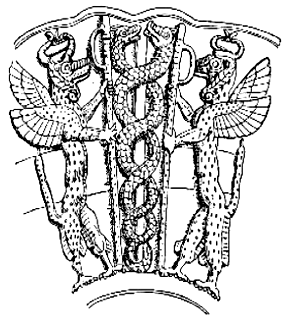 |
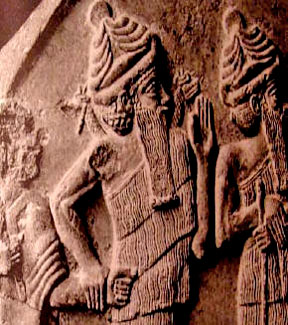 |
|
Seal of
Ningishzidda as entwined snakes around a rod
|
Ningishzidda
in human form with horned snakes on his shoulders |
|
 |
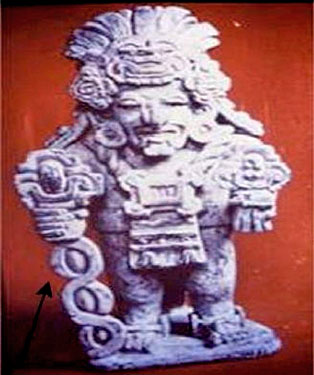 |
|
Quetzalcoatl
the feathered serpent |
Statue of
Quetzalcoatl with entwined snakes around a rod |
|
 |
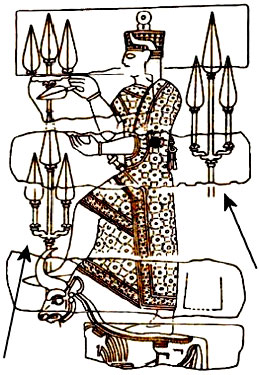 |
|
Ishkur/Teshub
holding the trident of lightnings and an axe |
Teshub
holding tridents similar to a candelabra |
|
 |
 |
|
Viracocha
holding lightnings and an axe |
The
‘Candelabra of the Andes’ symbol of Viracocha |
Let us now have a look at some findings
that establish a direct connection between Sumer/Africa and
Mexico/Peru.
The Fuente Magna Bowl
Fuente Magna is a region near Chua, on the shores of lake Titicaca,
circa 80 km from La Paz.
In 1992 an expedition in Chua
discovered a bowl, which was unearthed
by a local man some 30 years before, all covered with glyphs. The
stunning discovery was that the interior of the bowl was covered
with what at first sight seemed cuneiform signs. Photos of the
interior panel were sent to linguistics around the world, who
declared with no doubt that the writing system was Sumerian
cuneiform.
Among the various linguists studying the
bowl, we have to recall 2 important cases:
-
the Italian professor Alberto Marini gave a first translation declaring it was
Sumerian cuneiform
-
Prof. Clyde Winters on the other side
offers an even earlier date stating it was ‘proto-saharian’
cuneiform and that some of the cuneiform signs in the bowl were used
in the Sahara about 5000 years ago.
Clyde Winters was able to completely
translate the content of the interior of the bowl.
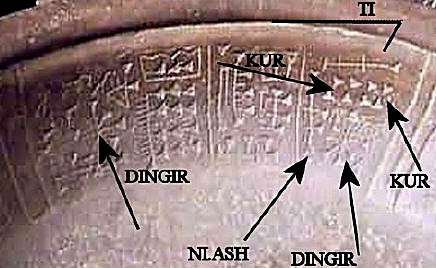
Sumerian cuneiform
signs in the Bolivian Bowl
In his study “Deciphrement of the
cuneiform writing on the Fuente Magna bowl” Winters clearly states
that, in order to analyze the glyphs, he had only used orthodox
material officially accepted from the establishment:
To translate the cuneiform I used
Samuel A. B. Mercer’s, Assyrian grammar with chrestomathy and
glossary (AMS Press,1966)
to compare the signs found on the Fuente bowl with the cuneiform
syllabary. To read the Sumerian text I used John L. Hayes, A
Manuel of Sumerian: Grammar and text (Udena Publications, 2000)
and John A Halloran, Sumerian Lexicon
After translating the panels of the
Fuente Magna bowl, Winters states that:
The cuneiform writing was
interesting for two reasons. First, we find that these panels
have proto-Sumerian symbols mixed with the cuneiform symbols.
Secondly, whereas, the wedges of most Sumerian cuneiform text
point leftward, the wedges of the Fuente cuneiform signs point
rightward.
This may result from the fact that
in the Fuente text , the letters are read from right to left,
instead of left to right like the cuneiform text from
Mesopotamia. The passage on the cuneiform panels of the Fuente
Bowl seems to be very similar to the Proto-Sumerian inscription
on the right side of the bowl.
The Fuente Magna bowl still remains the
most important finding supporting the link between Mesopotamic and
Mesoamerican cultures, establishing that Sumerians were able to
settle in Bolivia some 5000/4000 years ago..
Phoenicians and
Elamites in Peru and Bolivia
Between ’80s and ’90s a research project leaded by Bernardo Victor Biados Yacovazzo, chief director of the Institute for studies of
pre-colombian language in La Paz, and by E.F. Legner of the
University of California, examined dozens of locations in Peru and
Bolivia looking for archeological documentation which could help
clear some mysteries about pre-colombian cultures.
The result of all studies and the material gathered is fully shown
on their website (sadly only in Spanish) which is full of images and
‘anomalous’ findings..
The material they gathered shows without any doubt the contact among
Elamites, Phoenicians, Egyptians, Sumerians, and Babylonians with
the autochthonous tribes of both Peru and Bolivia.
Beside the already mentioned Fuente magna bowl, Yacovazzo discusses
about another famous finding: the Pokotia stelae, the stones and
glyphs of Tiwanaku, strange stone carvings, and a series of images
that compare the writing system used in southern Asia with the one
used in Phoenicia and Bolivia.
There is also a section about the
various stalae discovered in Bolivia that contain logo-syllabic and
cuneiform writing, of the same kind of the ones used in Egypt, Elam,
and writings that are identified as proto-elamitic and proto-hebrew.
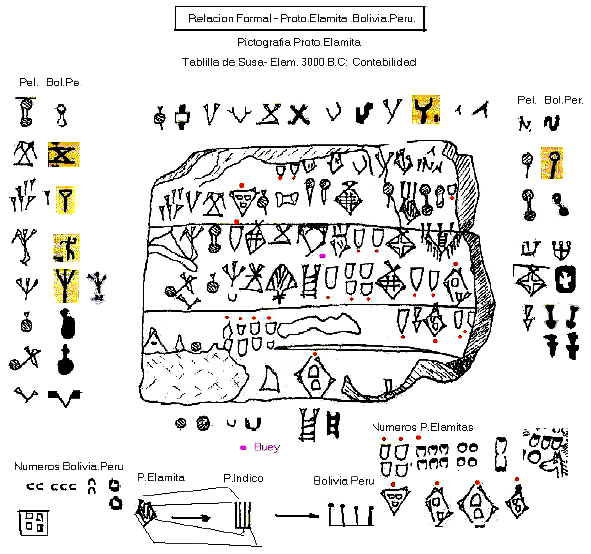
Pyramids,
Zigguratt, snakes, alignments and Sphinx
Few books deal with the correlation and the similarities that the
Pyramids and other megalithic monuments show with one another.
Almost any writer stops after noticing the alignment of a certain
building with some constellation, or the heliac rise, the moon etc.
Nobody has mentioned that if we connect
the Esagila in Babylon, the
Giza complex, and the
Teotihuacan complex, we obtain a perfect line
where the three points have less than 1 degree of misalignment.
We obtain a perfect line with the same
degree if we connect
Bad Tibira (an old Sumerian metallurgic site)
with Giza and going on to
Machu Picchu, the old Tampu Toco (a Mayan
metallurgic site in Peru).
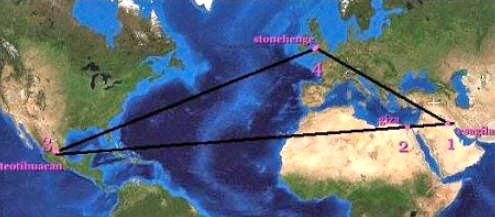
1: Esagila (Babylon)
– 2: Giza (Egypt) – 3: Teotihuacan (Mexico) – 4: Stonehenge
(Britain)
In the image above we have enclosed also
Stonehenge. How is it connected to the other sites?
We must remember that the Stonehenge I
was only made of some 50 holes in the ground forming a circle,
called ‘Aubrey holes’, and of seven vertical stones, six of which
were forming a circle and the seventh was a little out of the
circle, the famous Heelstone.
Well, we find a perfect match of these
in Lagash, in the courtyard of the Girsu, the temple of Ninurta: six
stones forming a circle and the seventh stone outside the circle.
Lagash is less than 1 degree distant
from Babylon, so if we connect Lagash and the Girsu with Giza we
obtain a line that points to Teotihuacan.
We then have:
-
Lagash: the Girsu with 7 stones
forming a circle (2100 B.C. circa)
-
Stonehenge (phase I): 7 stones
forming a circle (2900 B.C. circa)
-
Giza: 3 pyramids, 2 in a line,
and 1 a little on the left of the line (10500 B.C. circa
according to Sitchin – 2500 B.C. circa according to orthodox
Egyptologists)
-
Teotihuacan: 3 buildings, 2 in a
line, and 1 a little on the left of the line (3000 B.C.
circa)
Why did we have to notice these
similarities?
The common trait among these 4 locations
comes from the analysis of the importance, in these 4 cultures, of
the same recurring figure: the Serpent.
As we have already seen, at Sumer the serpent was a symbol for the
enkites, mainly Enki and his son Ningishzidda. What is less
documented is the importance of the Serpent among Druids and Celts,
which we know by some images depicting the god Cernunnos.
He was, as a matter of fact, depicted
with a serpent in his hands, as we can see in the image below.

Cernunnos
with the snake in the hand
Traces of the cult of the serpent in
Britain and northern Europe are also revealed by Balaji Mundkur in
his work “The cult of the serpent: an interdisciplinary survey of
its manifestations”.
For what concerns the serpent and the
other cultures, we have already discussed it in a wide manner, but I
think it is due to examine some other important similarities.
In both Mayan/Aztec and Egyptian iconography, the Sphinx had a human
face and used the same kind of hat going down to the shoulders and
showing the same horizontal carvings.
Both kind of hat had a serpent on the
forehead.

This is perfectly coherent with the
identification given by Sitchin of Thot/Ningishzidda/Quetzalcoatl: The Egyptian hats would show a serpent in honor of Thot, and the Olmec/Aztec/Mayan ones would show a serpent in honor
of Quetzalcoatl, both these deities identified with Ningishzidda.
It has been widely said that
the pyramids at Giza show a particular
alignment with the Orion Belt, explaining this as the try on behalf
of the egyptians to duplicate a stellar structure where they
conceived the Duat, the ‘path of Osiris’, according to the principle
of ‘As above so below’.
What other scholars do not mention, is that
Giza is not the only place where this alignment occurs. We find a
perfect match in Teotihuacan, in Mexico.
In both cases we have
-
two buildings in a perfect line (pyramids of Kheop and Kefrem in Giza – pyramid of Quetzalcoatl and of the Moon
in Teotihuacan)
-
another building laying slightly on the left of
this hypothetical line (pyramid of Menkaure in Giza – pyramid of the
Sun in Teotihuacan)
In the case of Giza we have an angle of
13 degrees, while at
Teotihuacan
we have an angle of 18 degrees.

Both sites have astrological meanings,
and are correlated to the cult of the dead:
-
from Giza (Rosteau) the
‘KA’ of the pharaoh begins its journey for the Duat
-
Teotihuacan is
the ‘path of the dead’ and the corridor connecting the tree building
is still called the ‘Corridor of the Dead’
Teotihuacan is voted to the cult of
Quetzalcoatl, and Giza is voted to the cult of Thot, both bounded
with the image of the serpent and the bird (a Quetzal in the case of
Quetzalcoatl and an Ibis in the case of Thot).
Common
mistakes?
Another very controversial discovery, ignored by most scholar and
never noticed by alternative researchers, is the common ‘mistake’ we
find in many statues and depictions in Mesoamerica, in Egypt, and in
Mesopotamia: people or gods depicted with 2 Left Hands.
One of the best known examples in
Babylonian culture is the famous image of Marduk and the Mushushu.
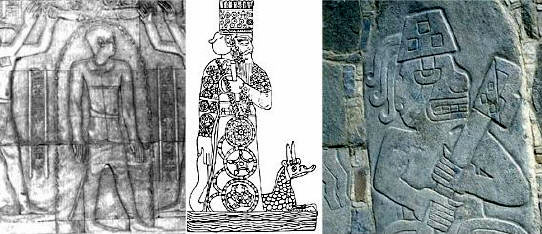
This was at first seen as a ‘perspective
mistake’ made by sculptors not being able to correctly represent the
depicted characters with one hand showing the palm and the other
showing the back to the viewer.
It seems very strange that people who
correctly carved and aligned monuments like the pyramids or depicted
jewels like the Dendera Zodiac, or the incredibly small cuneiform
signs in diorite (one of the hardest materials to carve), or the
incredibly detailed statues of Chichen Itza, had so much trouble in
depicting two hands.
Moreover it would require an extremely
strange coincidence to allow that 3 civilizations in distant places
could make the same mistakes.
The reason the iconography shows this
particular of the two left hands is unknown, but is a clear evidence
that the three civilization were bounded or shared the same origin.
Again on Clyde
Winters
Clyde Winters, whom we have already mentioned, is a linguistic
scholar and archeologist specialized in the comparison of dead
languages and the customs of different cultures. His studies are
worldwide accepted and appreciated, and used in many universities,
but completely ignored by the establishment and the big ring of the
‘mainstream science’.
These studies range from the
identification of
the Olmecs as a mixed population mostly made up of
African people, to the finding of the resemblance and derivation of
many terms in the Chinese, Mesoamerican, Mesopotamic languages, to
the decipherment of the Meroitic and Dravidian languages.
Winters produced a huge series of
documents, images, tables, that strongly put in correlation the
Sumero-Akkadian and Babylonian civilization with the Hindu, Elamitic,
Egyptian, Nauhatl, Mexican, and Phoenician.

Image of the Fuente
Magna bowl showing the sumerian sign ‘DINGIR’.
But Winters is also an excellent
discloser: in his studies he offers a tribute to many scholars in
paleontology, archeology, linguistics, naturalistic sciences and
genetics that prove the Mesopotamic and African origin of the
Mesoamerican civilizations. And as we have already seen this is a
focal point in Sitchin’s theory.
It is due to particularly observe the analysis of the Pokotia stelae
discovered by Bernardo Biados Yacovazzo and his treatise
about the African origin of the Olmecs.
Regarding the Pokotia stelae, Winters writes:
“The Pokotia inscriptions show
affinity to the inscriptions found on the Fuente Magna bowl” and
later in the same documents, “The Pokotia inscriptions are
written in the Sumerian language. The signs are related to the
Proto-Sumerian writing. The phonetic values for the signs are
the phonetic values of similar signs found in the Vai writing.
The sounds for the Vai writing were also used to interpret the
Olmec writing and Indus Valley writing.”
The
Pokotia stelae also shares with the
Fuente magna bowl a crucial common trait:
“The symbols on the Pokotia statue
are read from top to bottom, right to left. The signs have
syllabic values.”
They are carved to be read from right to
left, while the Mesopotamic signs of later ages were carved to be
read from left to right.
This is, according to Winters, a precise
indication that there was a migration from Mesopotamia to
Mesoamerica about 5000/5500 years ago, and the writing system did
not undergo the evolution occurred in Mesopotamia where the reading
direction changed during time. Thanks to Winters’ documents we also
discover that Fuente Magna and Pokotia are not the two only cases
witnessing the journey of Sumerians in Mesoamerica.
He quotes studies of earlier scholars
(e.g. M.E.Moseley) that report the findings of some bricks in
Tiwanaku, Moche, Virù and Nepena in the northern part of Peru.
Some of the bricks unearthed in Moche contain the cuneiform signs
for “Na, I, A, Mash/bi, Mi, Ma, Po, Ki, Ta” with a perfect match
with the ones from the Pokotia stelae, while a portrait on a plate
found in Tiwanaku contains the glyphs corresponding to “Me, Mash/bi”
matching the ones in the Fuente magna bowl.
In the document entitled, “Skeletal evidence of African Olmecs” we
learn that the idea of African Olmecs is not new.
It indeed dates
back to 1972 when Dr. Wiercisky gathered some evidence from the
analysis of some skeletons found buried in well-known Olmecs sites.
In the site at Tlatilco (Mexico) the 13.5% of unearthed skeletons
had negroid traits, in the sites at Cerros de las Mesas the
correspondence was 4.5%.
Although all these studies and
comparisons were later disclosed by Jairazbhoy in 1975 and again by
Rensberger in 1988, they are completely hidden or ignored by
orthodox scholars.
The ethnographic and ethnologic
community particularly opposes to the disclosure of these documents
not even accepting to discuss these findings and their implications,
often stating that they are recent African skeletons of people who
arrived in Peru and Mexico after the Spanish conquer and someway
‘penetrating’ the earth strata.
A typical example of the behavior of orthodox scholars comes from
Diehl and Coe of Harvard University who in 1995, in their document
“Olmec Archeology”, stated that,
“One cannot accept the hypothesis of
a contact between Africans and Olmecs until an African skeleton
is found in a well known Olmec area” completely ignoring the
findings disclosed by Wiercinsky and Irwin in Mexico.
Winters also reports the considerations
made by C. Marquez and M. Desplagnes who, respectively in 1956 and
in 1906, had already noticed a resemblance between the negroid
traits of Africans and the ones shown in Olmec statues.
We can read hereafter the methods used to determine the resemblance
between African and olmecs skeletons:
To determine the racial heritage of
the ancient Olmecs, Dr. Wiercinski (An anthropological study on
the origin of Olmecs – 1972) used classic diagnostic traits
determined by craniometric and cranioscopic methods. These
measurements were then compared to a series of three crania sets
from Poland, Mongolia and Uganda to represent the three racial
categories of mankind.
Later in his documents, Winters offers
an analysis made by well-known genetists Cavalli Sforza, Keitha,
Kittles, Wuthenau, who were able to trace a chronology of migrations
from the Saharan region to Mexico and Peru:
The Olmec came from Saharan Africa
3200 years ago. They came in boats which are depicted in the
Izapa Stela no.5, in twelve migratory waves. These Proto-Olmecs
belonged to seven clans which served as the base for the Olmec
people.
Linguistic
resemblances
By analyzing the terms for proper names, objects, and locations used
in the middle east and in Mesoamerica, it is stunning how many
correspondences we find, often being almost perfect matches.
In “The lost realms”, Zecharia Sitchin
reports of some similarities discovered by modern linguists that
relate the term ‘Manco’, used to describe the Inca kings, to a
similar term used in semitic languages meaning ‘King’. A similar
analysis was made around the term ‘Meshica’ which is not Nauhatl but
is used in some Mesoamerican celebrations singing, 'Yo Meshica,
He Meshica, Va Meshica', and is put in relation with the term
Mashi’ach from which ‘Messiah’ would derive.
Other terms with a clear resemblance are
the Nauhatl ‘Tupal’ with the Babylonian ‘Tubal’ (that arrived to us
via the Bible and the Semitic name Tubal, e.g. in Tubal Cain), the
Nauhatl ‘Nusan’ with the Semitic ‘Nissan’ and Babylonian ‘Nisannu’,
and the Nauhatl ‘Tic’ with Acadian ‘Ticu’.
We can also find a Nauhatl legend involving the ‘Priest Balam the
Jaguar’, who finds a perfect match in the Egyptian records about a
priest called Balaam whom the King of Moab asked to cast a curse
against the Israelites.
Other terms that offer an incredible
resemblance are the Mesopotamic ‘Choi’, corresponding to the
Mesoamerican ‘Chol-ula’, the Mesopotamic ‘Zuibana’ related to the
Mesoamerican ‘Zuivan’, and the Mesopotamic ‘Zalissa’ related to the
Mesoamerican ‘Xalisco’.
In his book “Linguistic archeology
- An introduction”, Edo Nyland
deals with the pre-Japanese language of the Ainus, putting it in
relation to the northern African language and
the Basque.
Basque has
always been considered a real mystery by scholars, and it is not
secondary to mention that it is, like Sumerian, an agglutinative
language.
Let us read what Nyland writes:
“For instance, the many names
beginning or ending with ‘ama’ (Goddess) are all thought to be
of Ainu origin. In 1994 the newly married prince and princess of
Japan traveled to the cave of the ‘Goddess Amaterasu’ to ask her
blessings for their marriage. The name Amaterasu is agglutinated
from ‘ama-atera-asu’, ‘ama’ (Goddess) ‘atera’ (to come out, to
appear) ‘asturu’ (blessings flow): Blessings flow when the
Goddess appears. This name is made up of perfect Basque!”
Clyde Winters too offers an analysis of
two important terms.
He reports that one of the locations
discovered by Yacovazzo was called ‘Potosi’ and puts this name in
relation with the Sumerian term ‘Patesi’ who indicates the dynasty
of priest-kings (the name was similar in meaning to the more famous
Lugal).
The same term ‘Inca’, according to
Winters, may have been an evolution of the Sumerian ‘En.Ka/En.Gal’
meaning ‘Great Lord’.
Sources
-
Sitchin:
The Lost Realms
-
Sitchin:
The Lost Book of Enki
-
Winters: African Origin of
Olmecs
-
Winters: An Anthropological
Study on the origin of the Olmecs
-
Winters: Pokotia Inscriptions
-
Winters: Skeletal Evidence of
African Olmecs
-
Winters: The Proto-Saharan
Civilization
-
Winters:
Decipherment of The Cuneiform Writing of the Fuente Magna Bowl
-
Yacovazzo: Petroglyphs and
Pictographs
-
Yacovazzo: Phoenicians in Brazil
-
Wiercinsky: An anthropological
study on the origin of "Olmecs"
-
Nyland: Linguistic Archaeology:
An Introduction
Websites
|
















